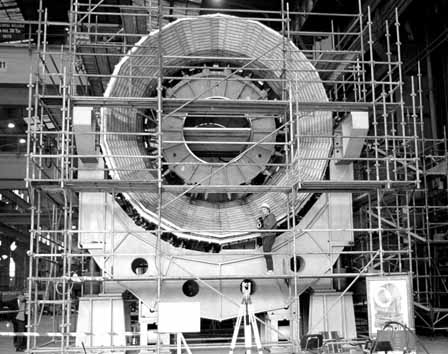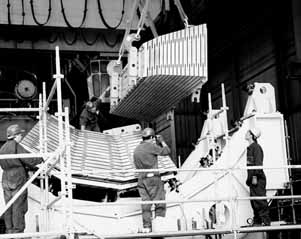 |
|
CMS HCAL: Copper Colossus by Mike Perricone
"The CMS HCAL barrel and endcap will weigh about 1600 tons when completed, and most of that is copper. It will be the heaviest copper alloy structure ever built," said Freeman, technical coordinator for the HCAL construction. Freeman has become something of a monument maven during this project, providing a major component for the Large Hadron Collider at CERN, the European particle physics laboratory in Geneva, Switzerland. He offered these HCAL comparisons: "The Statue of Liberty weighs 254 tons, about half of which is cast iron and the other half copper sheet. The legendary Colossus of Rhodes is estimated to have weighed 275 tons. Probably 90 percent of it was bronze, a copper alloy, with some iron bracing inside. It's interesting to note that the Colossus was just about the same size as the Statue of Liberty, ignoring the different pedestals." The November decision by CERN to suspend operations of the Large Electron-Positron collider, and proceed on schedule with construction of the LHC, turned a spotlight on Fermilab's Run II research prospects for the next five years while CERN retools. The spotlight also illuminated Fermilab's major partnership in building the LHC. Alongside its own all-out campaign to begin Run II of the Tevatron in March, and construction of neutrino experiments NuMI and MiniBooNE, Fermilab is also managing an effort for both LHC accelerator and detector components extending throughout virtually every lab production facility. CMS alone could consume the resources of some institutions. "This is a $167 million project. So far we've committed about $80 million, meaning we're just about half done," said Dan Green, project manager for the US/CMS collaboration. "CERN typically keeps strict schedules, and the clock is ticking now that LEP has ended its run. The present CERN schedule calls for a trickle of beam and some collisions in late 2005, and then for the LHC to start running in 2006." The new collider will achieve a center-of-mass energy of 14 TeV, some seven times the energy of the Tevatron. In mounting proton-proton collisions, LHC will have beam crossings every 25 nanoseconds (compared to 396 nanoseconds to begin Run II, and 132 nanoseconds by the end of Run II), anticipating 20 to 30 collisions at every beam crossing. The luminosity, a measure of the collision rate, will reach 1034cm 2/sec, about 100 times that of the Tevatron.
"The physics goals for LHC are approximately the same as for Run II, but with a higher guarantee of success for physics beyond the Standard Model," said John Womersley, cospokesperson for Fermilab's DZero detector, and a CMS collaborator who has also served as physics coordinator for US/CMS. "While the Tevatron can search for the Higgs up to about 200 GeV, LHC can cover the whole Higgs mass range to more than 800 GeV. LHC can also guarantee a mass range up to the highest levels we can conceive of for Supersymmetry particles." Those goals translate into stringent standards for CMS, which must offer precision measurements with the high collision rate.
Fermilab also will serve as the regional computing center for US/CMS, which includes nearly 400 scientists from 37 institutions across the country. (The worldwide CMS collaboration numbers approximately 1,800 scientists in 144 institutions.) They all need data, and Fermilab is building the system for taking data from CERN and sending it through the US/CMS distribution grid by turning a "reverse angle" on its own experience as a data source for national and international collaborations. "A major Fermilab contribution will be showing how to extract physics from this complex environment, how to make sense out of LHC," Womersley said. "We're not just knocking on the door asking to be invited to the party. Fermilab knows how to do all this."
US/CMS Roundup US/CMS Project Manager Dan Green says his role is to "find good people and turn them loose. I run interference so they can do useful work. And they're cooking away." Some high points: Computing: Lothar Bauerdick, recently of DESY, is the new Level I manager for the US/CMS software and computing project building the regional computing hub at Fermilab. "We're already using fully functional prototypes of the software," he says. The head of the CMS computing group in Fermilab's Computing Division, Vivian O'Dell is now working with a staff of 11 people, and buying computing facilities that she expects eventually to surpass the computing for Run II "simply because the same amount of computing gets cheaper the later you buy it." Fermilab has already simulated more than four million Monte Carlo events for US/CMS. SiDet: The unique facility is in the early stages of producing silicon strip modules for the CMS tracker outer barrel, and silicon pixel disks for the CMS forward tracking system. The first of two robots will arrive shortly. They will use precision linear encoders and optical pattern recognition to assume and automate some tasks formerly performed by technicians building CDF and DZero detectors. "Aside from the use of the robots, assembling the strip detectors is pretty much the same," reports SiDet associate head Lenny Spiegel. "Pixel detectors, on the other hand, represent a new challenge for SiDet." Muon chambers: The endcap muon chambers, or cathode strip chamber (CSC) system being machined and assembled at Lab 8 and MP9, is the largest of its kind anywhere by a factor of 10. More than 20 chambers have been built, including prototypes for the Russian and Chinese chambers. In all, nearly 500 chambers will be built with six layers in each chamber.
Pixels: A revised design for the forward tracker has three disks at each end, for a total of 43 million pixels. Arranged like turbine blades on the disk, each individual detector is 8 mm x 10.45 mm, with a 52x53 pixel array, and is equivalent to 380K transistors. Beam tests will establish the best overlap angle for charge sharing, producing a resolution up to 15 microns (millionths of a meter). Among these detectors' responsibilities: putting a time stamp on the bunch crossings, 25 nanoseconds (billionths of a second) apart. New chips: Ray Yarema's microelectronics group is developing two radiation-hard chips for HCAL, one (QIE) based on earlier chips for CDF and KTeV and the other (CCA) an entirely new design. QIE takes signals from photomultiplier tubes and digitizes them over a wide dynamic range at high frequency. CCA takes output data from QIE chips and provides phase adjustment for data, and interfaces to the DAQ system.
For more information,
|
| last modified 1/19/2001 email Fermilab |
FRLsDFx9eyfrPXgV
 Jim Freeman doesn't need hyperbole when describing the stature of the Hadron Calorimeter for the Compact Muon Solenoid. The facts alone place this detector subassembly in rare company.
Jim Freeman doesn't need hyperbole when describing the stature of the Hadron Calorimeter for the Compact Muon Solenoid. The facts alone place this detector subassembly in rare company.
 The CMS electromagnetic calorimeter (ECAL) design is based on a lead tungstate crystal similar to that used in Fermilab's KTeV fixed-target experiment, which broke new ground in CP violation research with direct observations of time asymmetry. Fermilab is building the hadron calorimeter (HCAL), the copper colossus located directly behind the crystal ECAL. HCAL is similar in design to the end plug calorimeter at Fermilab's CDF detector, and the proposed SDC calorimeter at the SSC. The magnetic field inside CMS will be 4 Tesla, double the strength of DZero (2T) and nearly three times that of CDF (1.4T). The higher magnetic field produces more bending, and thus higher differentiation, in particle tracks. CMS has an all-silicon tracker, with a critical production role for Fermilab's Silicon Detector Facility, already setting new standards with Run II detectors.
The CMS electromagnetic calorimeter (ECAL) design is based on a lead tungstate crystal similar to that used in Fermilab's KTeV fixed-target experiment, which broke new ground in CP violation research with direct observations of time asymmetry. Fermilab is building the hadron calorimeter (HCAL), the copper colossus located directly behind the crystal ECAL. HCAL is similar in design to the end plug calorimeter at Fermilab's CDF detector, and the proposed SDC calorimeter at the SSC. The magnetic field inside CMS will be 4 Tesla, double the strength of DZero (2T) and nearly three times that of CDF (1.4T). The higher magnetic field produces more bending, and thus higher differentiation, in particle tracks. CMS has an all-silicon tracker, with a critical production role for Fermilab's Silicon Detector Facility, already setting new standards with Run II detectors.